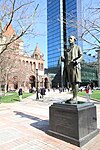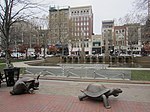John Hancock Tower

200 Clarendon Street, previously John Hancock Tower and colloquially known as The Hancock, is a 62-story, 790-foot (240 m) skyscraper in the Back Bay neighborhood of Boston. It is the tallest building in New England. The tower was designed by Henry N. Cobb of the firm I. M. Pei & Partners and was completed in 1976.The building is widely known for its prominent structural flaws, including an analysis that the entire building could overturn under certain wind loads—as well as a prominent design failure of its signature blue windows, which allowed any of the 500-lb. window panes to detach and fall—up to the full height of the building—endangering pedestrians below. In 1977, the American Institute of Architects presented the firm with a National Honor Award for the building, and in 2011 conferred on it the Twenty-five Year Award. It has been the tallest building in Boston and New England since 1976. The street address is 200 Clarendon Street, but occupants also use "Hancock Place" as a mailing address for offices in the building. John Hancock Insurance was the primary tenant of the building at opening, but the company announced in 2004 that some offices would relocate to a new building at 601 Congress Street, in Fort Point, Boston. The tower was originally named for the insurance company that occupied it. The insurance company, in turn, was named for John Hancock, whose large and conspicuous signature on the Declaration of Independence made his name so famous in the United States that a colloquialism for a signature is "a John Hancock".
Excerpt from the Wikipedia article John Hancock Tower (License: CC BY-SA 3.0, Authors, Images).John Hancock Tower
Clarendon Street, Boston Back Bay
Geographical coordinates (GPS) Address External links Nearby Places Show on map
Geographical coordinates (GPS)
| Latitude | Longitude |
|---|---|
| N 42.349277777778 ° | E -71.074777777778 ° |
Address
200 Clarendon
Clarendon Street 200
02116 Boston, Back Bay
Massachusetts, United States
Open on Google Maps








